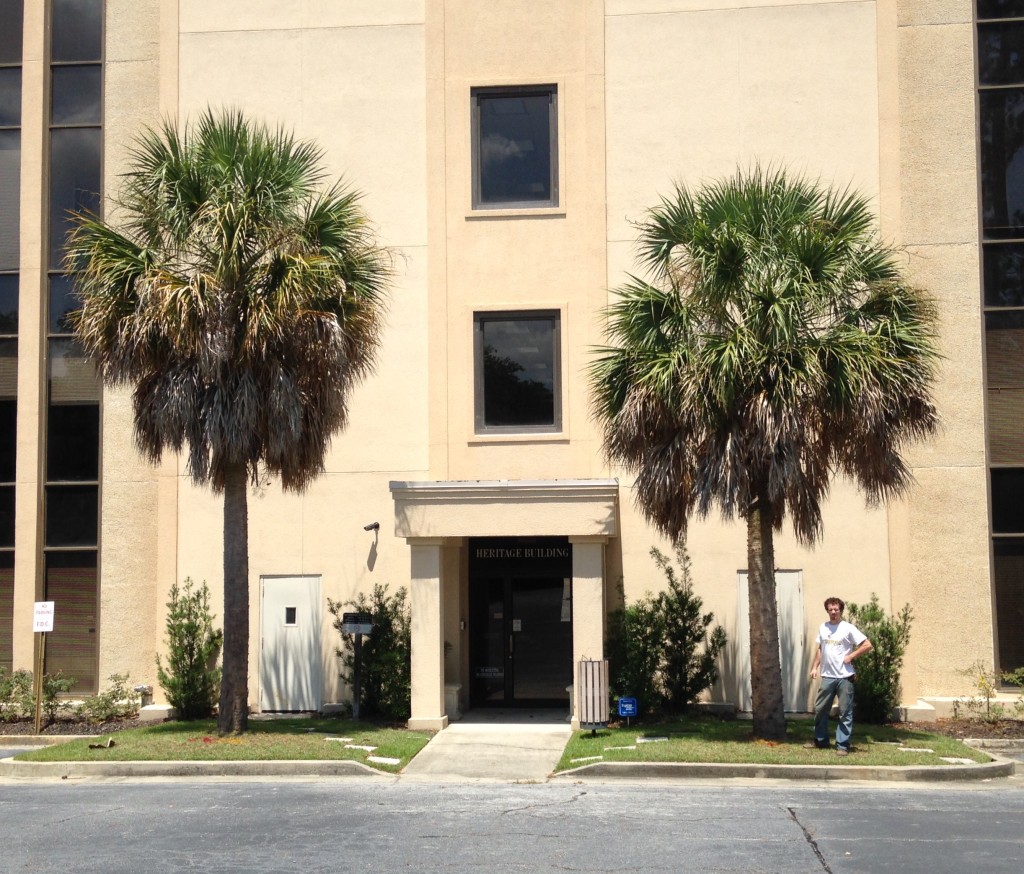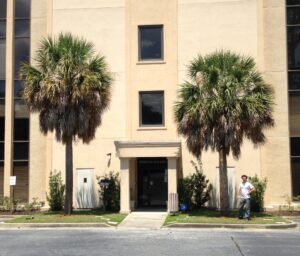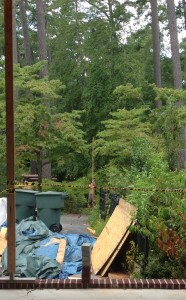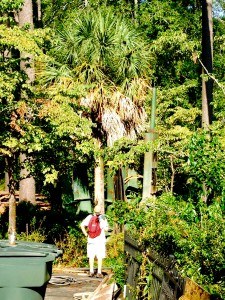
Salvaging Spectacular Sabal Palms
Performance Anxiety You’d think gardening might be a stress free job. But right now, I feel dread like a hole below my chest that you could put a 3-gallon nursery pot through.
This upcoming job has no little 3-gallon pots though. We’re moving two, 50+year old, 30 feet tall, spectacular Sabal palms. And it’s going to be complicated, dangerous and a bit of a gamble.
It’s cool — we’re saving these two from possible destruction, salvaging them from a commercial building that is being renovated. And now that I’ve told you and the clients how great this will be, I want it to be! But, what if? What if we hit a fiber optic line and throw 10,000 people and dry cleaners out of internet? What if the tree breaks? What if the truck gets stuck? Or a leg gets broken or the hole don’t dig? It’s a potential country song, a potential embarrassment and a potential waste of money.
So days before the move, I sat in my pick up at a gas station, with that big hole in my chest. Or in my stomach. You know the feeling. Maybe it’s a good thing. Maybe that moment of dread helps slow me down, assess, and insure I double check details. Yep, I called before I dug, I sited the plants, about 8 times, got the soaker hose, irrigation supplies, mulch, and crossed all the t’s. To get out of that moment of dread, I checked the list twice.
Salvage Operation Those stresses and risk are the reasons people don’t often salvage specimen plants. But it’s such a good thing, such the right thing to do. It reduces waste and ‘grey energy’ (the energy used/wasted between where something originates and the end user). Instead of planting new palms, which are often dug from the wild, stripped, shipped up I-95, babied for a few years, these two get moved just a mile down the road.
My old buddy drove his 90-inch tree spade truck in from his nearby farm. The first step is to set the truck, the spade and to dig the first hole. Each blade has 80,000 pounds of pressure — he says that’s equal to a tractor-trailer truck jumping on the big shovel blade. So there’s stress in this — if there is anything down there we couldn’t see, the blades will cut right through it.
Then, we go to the palmettos, dump that dirt, set up the truck and hoist up the first palmetto. Back in the garden, she gets a little pruning, to remove leaves that might transpire too much water in the heat. And we clean her up just a bit with a simple pruning– just a haircut. We’ll also coat the leaves with an anti-transpirant to reduce transpiration of water and spray of micronutrients via kelp fertilizer. And she’s all snuggled into her new home.
The hole is key. There is little room but we snake a soaker hose around the roots. The soaker hose will be only, only, only managed by Collin or me; no automated system could judge when this palmetto needs water. We fill with coarse white sand and a drench of kelp fertilizer.
The process is repeated for the second palm. Just like I’ve repeated this for dozens of trees over 25 years. Salvaging these two stately dames was the right thing to do. They are living, amazing creatures and we are their stewards. A little stress, a few moments of that empty stomach dread, and a day of hard, hot work by our crew is all worth it to see these palmettos settled in for the next hundred years. (Slide show photographs taken by Hunter Desportes)
How Did We Know Where To Plant Them?
In the pictures you see the garden is being totally renovated. Basically, it’s a construction site. I’ve been working on a plan for a while now; visiting in various lights, times, even in rain storms. The two palmettos were strategically placed to be focal points down the road. The taller one went on the low side of the garden, so in the long run, the two look about the same height. It’s going to be a focal point from a main axis and view from inside the house. The second, shorter one had a wider leaf canopy. It was placed to help insure privacy from neighbors once the pool and garden are built.




Awesome job!
That is a great job! So glad those two were saved! I love palms!
Me too Libby, but they are often mis treated! And so often not integrated into a garden….
Thanks Will, I’m lucky to have clients who want to do this sort of thing.
Jenks, you are an amazing person. This is awesome.
Thanks! It took a lot of focused people to do this and get the pictures!
Jenks, this is spectacular! What a incredible job you and Collin did with this project, and thanks to Hunter for the great photos
Amazing job, Jenks!
I love it when you can rescue a tree and have just the perfect place to put it. The palms certainly got a good home and I am sure will truly be appreciated.
We’re watering it daily with soaker hoses!
It is a wise man who plants a tree he will never sit under, but an even wiser one who moves a grown
It is a wise man who plants a tree he will never sit under, but an even wiser one who saves a full grown palm that everyone can still enjoy today and the future.
I want to move several PALMETTO’s on my new lot that are blocking the view on my home site. I want to move them to the other side of the property. I am on Edisto. I have some guys that said they might be able to do it with their back hoe. Do you think that it is possible? Also how do I protect them with the treatments you described?
Yes, that’s possible. The key to moving a palmetto is to treat the tip, the head like it’s made of glass. If that tip falls over, bounces or get’s damaged, you’re done for. The roots are not so important — they’re going to make new roots anyway. So you do not need a huge root ball. But palmettos are REALLY heavy and top heavy. Trim lots of the leaves. And best case is to wait until spring when the ground is warm. I always put a soaker hose in the hole, wrapped around the root ball and use that all summer.